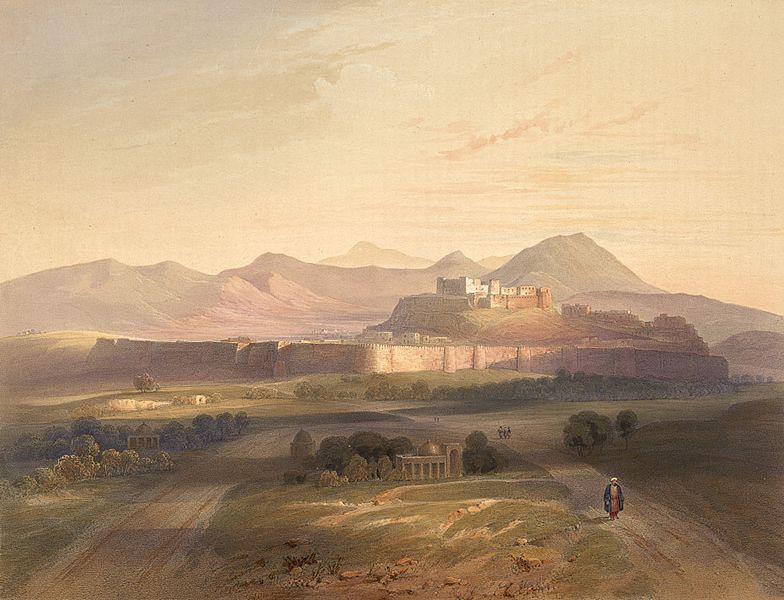Image: Ghazni City during 1839-42

Description: Town and Citadel of Ghuznee This lithograph was taken from plate 18 of 'Afghaunistan' by Lieutenant James Rattray. This sketch was made near some mosques outside the Kandahar Gate to the west side of Ghazni, a city Rattray visited several times. Ghazni had enjoyed its principal moment of glory 800 years earlier when it was the capital of an empire extending from the Armenian mountains to the fertile plains of the Ganges. Rattray wrote that it was now again well-known, "thanks to our love of territorial aggrandisement, and the occasional desertion of war's fickle deity from our ranks". He described riding slowly over a wide plain, dotted with relics of past ages, to Ghazni: "Interspersed with this havoc of centuries, as far as the eye could reach, were a succession of rich groves, vineyards, flower-gardens, melon-beds and orchards [while] in the blue distance, its white structures just discernable from the mountains it springs from, rested Ghuzni, with its bastions, town and citadel." On 6 September 1842, Ghazni was for a second time wrested from the Afghans by the British under General Nott. On taking possession of the city, the engineers were given two days to blow it up. When Rattray last glimpsed it, "far-famed Ghazni was a heap of smoking ruins".
Title: Ghazni City during 1839-42
Credit: The British Library
Author: Lieutenant James Rattray
Permission: This work is in the public domain in its country of origin and other countries and areas where the copyright term is the author's life plus 70 years or less. You must also include a United States public domain tag to indicate why this work is in the public domain in the United States. Note that a few countries have copyright terms longer than 70 years: Mexico has 100 years, Jamaica has 95 years, Colombia has 80 years, and Guatemala and Samoa have 75 years. This image may not be in the public domain in these countries, which moreover do not implement the rule of the shorter term. Côte d'Ivoire has a general copyright term of 99 years and Honduras has 75 years, but they do implement the rule of the shorter term. Copyright may extend on works created by French who died for France in World War II (more information), Russians who served in the Eastern Front of World War II (known as the Great Patriotic War in Russia) and posthumously rehabilitated victims of Soviet repressions (more information). This file has been identified as being free of known restrictions under copyright law, including all related and neighboring rights. This work is in the public domain in its country of origin and other countries and areas where the copyright term is the author's life plus 70 years or less. You must also include a United States public domain tag to indicate why this work is in the public domain in the United States. Note that a few countries have copyright terms longer than 70 years: Mexico has 100 years, Jamaica has 95 years, Colombia has 80 years, and Guatemala and Samoa have 75 years. This image may not be in the public domain in these countries, which moreover do not implement the rule of the shorter term. Côte d'Ivoire has a general copyright term of 99 years and Honduras has 75 years, but they do implement the rule of the shorter term. Copyright may extend on works created by French who died for France in World War II (more information), Russians who served in the Eastern Front of World War II (known as the Great Patriotic War in Russia) and posthumously rehabilitated victims of Soviet repressions (more information). This file has been identified as being free of known restrictions under copyright law, including all related and neighboring rights.
Usage Terms: Public domain
License: Public domain
Attribution Required?: No
Image usage
The following 2 pages link to this image:

